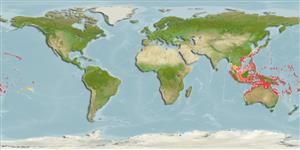Environment: milieu / climate zone / intervalo de profundidade / distribution range
Ecologia
marinhas associadas(os) a recifes; intervalo de profundidade 3 - 46 m (Ref. 1602), usually 9 - 46 m (Ref. 1602). Tropical; 24°C - 28°C (Ref. 27115); 35°N - 32°S, 95°E - 139°W
Pacific Ocean: Christmas Island and Cocos-Keeling Islands in the eastern Indian Ocean to the Hawaiian and Tuamoto islands, north to Japan, south to Lord Howe Island. Replaced by Acanthurus tennenti in the Indian Ocean (Ref. 37816).
Tamanho / Peso / Idade
Maturidade: Lm ? range ? - ? cm
Max length : 35.0 cm TL macho/indeterminado; (Ref. 2334); Idade máx. registada: 33 anos (Ref. 52229)
Espinhos dorsais (total) : 9; Raios dorsais moles (total) : 23 - 25; Espinhos anais: 3; Raios anais moles: 22 - 24. Body of adult dark grayish brown; juveniles yellow; posterior to upper end of gill opening is a bright orange horizontal band, with purplish black border. Head and anterior half of body usually abruptly paler than the posterior half. Anterior gill rakers 24-28; posterior 23-27. Large adult males (about 17 cm) with more definite convexity of snout profile.
Body shape (shape guide): short and / or deep; Cross section: compressed.
Inhabit seaward reefs, in areas of bare rock or mixed rubble and sand, from 9 to at least 46 m depth; juveniles inhabit protected bays and lagoons, singly or in small groups in as little as 3 m (Ref. 1602, 48637). Benthopelagic (Ref. 58302). Adults occur singly or in schools and feed on surface film of detritus, diatoms, and fine filamentous algae covering sand and bare rock (Ref. 1602). Rarely poisonous (Ref. 4795).
Life cycle and mating behavior
Maturidade | Reprodução | Desova | Ovos | Fecundidade | Larvas
Randall, J.E., 1956. A revision of the surgeonfish genus Acanthurus. Pac. Sci. 10(2):159-235. (Ref. 1920)
Categoria na Lista Vermelha da IUCN (Ref. 130435: Version 2025-1)
Utilização humana
Pescarias: espécies comerciais; Aquário: Espécies comerciais
Ferramentas
Relatórios especiais
Descarregue XML
Fontes da internet
Estimates based on models
Preferred temperature (Ref.
123201): 24.5 - 28.7, mean 27.3 °C (based on 356 cells).
Phylogenetic diversity index (Ref.
82804): PD
50 = 0.5000 [Uniqueness, from 0.5 = low to 2.0 = high].
Bayesian length-weight: a=0.02630 (0.01711 - 0.04044), b=3.00 (2.88 - 3.12), in cm total length, based on LWR estimates for this species & Genus-body shape (Ref.
93245).
Nível Trófico (Ref.
69278): 2.3 ±0.17 se; based on food items.
Generation time: 1.0 ( na - na) years. Estimated as median ln(3)/K based on 1
growth studies.
Resiliência (Ref.
120179): Muito baixo, tempo mínimo de duplicação da população maior que 14 anos (tmax=33).
Fishing Vulnerability (Ref.
59153): Low vulnerability (18 of 100).
🛈
Nutrients (Ref.
124155): Calcium = 69.2 [29.5, 211.4] mg/100g; Iron = 0.926 [0.341, 2.370] mg/100g; Protein = 18.5 [17.2, 19.7] %; Omega3 = 0.109 [0.049, 0.238] g/100g; Selenium = 23.8 [8.1, 73.5] μg/100g; VitaminA = 23.6 [5.9, 93.8] μg/100g; Zinc = 2.68 [0.83, 4.91] mg/100g (wet weight);
